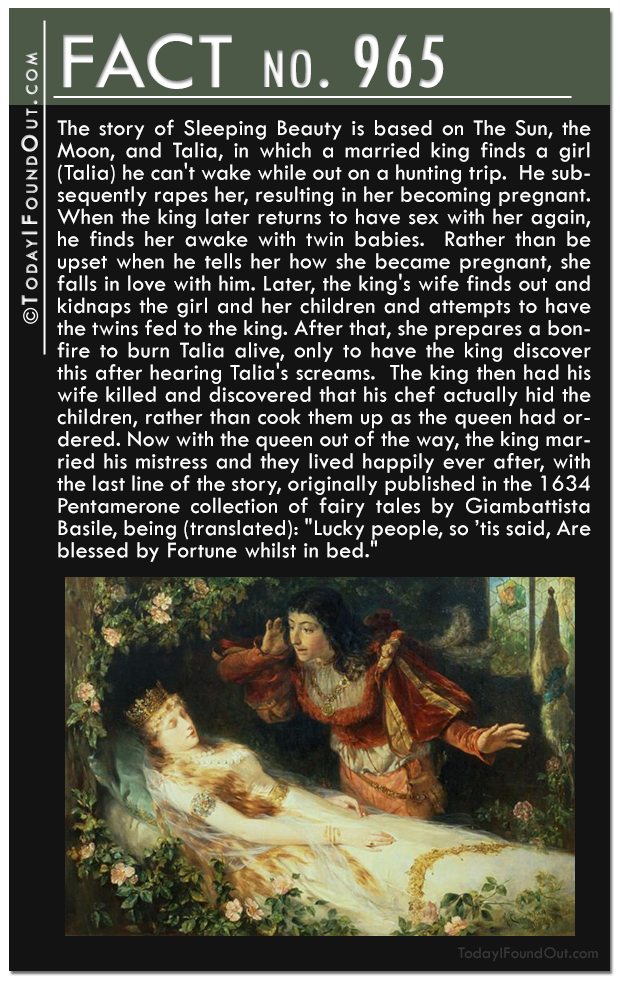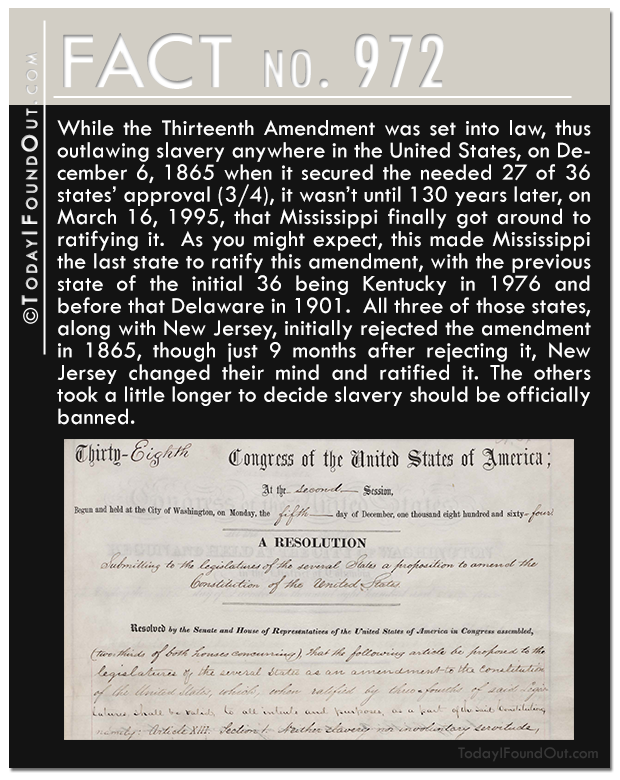Mailing Children, The 24 Hour Puppy Channel, the Bizarre Origins of Sleeping Beauty and More in Yet Another 10 Amazing Quick Facts
964) When Parcel Post Service first launched in America on January 1, 1913, there were few guidelines on what could be mailed. As a result, a handful of parents, spotting a bargain, began mailing their children. The first known case of this was the child of Mr. and Mrs. Jesse Beauge of Ohio only a few weeks after the launch of Parcel Post. They sent their son to his grandmother’s house for a fee of just 15 cents (about $3.72 today). On January 27, 1913, Mr. and Mrs. J.W. Savis of Pennsylvania mailed their daughter to relatives for a fee of 45 cents. More famously, 5 year old May Pierstorff of Idaho was mailed on February 19, 1914 73 miles to her grandmother’s house at a cost of just 53 cents (about $13.13 today). This was significantly cheaper than sending her on a passenger train, with the train ticket in question costing $1.55 according to the book, Mailing May. May’s case helped push forward an inquiry on the matter of mailing children and ultimately led to Postmaster General Albert Burleson declaring that, from that point forward, it was against the rules to mail human beings. Despite this, the practice continued for about two more years, finally stopping after an investigation into why three year old Maud Smith of Missouri was allowed to be mailed to her grandparents’ house in Kentucky. While you might have visions of children being put in boxes with holes in the side for air, this was not how the children were mailed. The appropriate number of stamps were simply affixed to their clothing along with the address they were to be sent. From there, they accompanied postal workers on the trains along with normal packages and then were escorted to their destinations.
965) The story of Sleeping Beauty is based on The Sun, the Moon, and Talia, in which a married king finds a girl (Talia) he can’t wake while out on a hunting trip. He subsequently rapes her, resulting in her becoming pregnant. When the king later returns to have sex with her again, he finds her awake with twin babies. Rather than be upset when he tells her how she became pregnant, she falls in love with him. Later, the king’s wife finds out and kidnaps the girl and her children and attempts to have the twins fed to the king. After that, she prepares a bonfire to burn Talia alive, only to have the king discover this after hearing Talia’s screams. The king then had his wife killed and discovered that his chef actually hid the children, rather than cook them up as the queen had ordered. Now with the queen out of the way, the king married his mistress and they lived happily ever after, with the last line of the story, originally published in the 1634 Pentamerone collection of fairy tales by Giambattista Basile, being (translated): “Lucky people, so ’tis said, Are blessed by Fortune whilst in bed.”
966) While watching news of the O.J. Simpson trial in the mid-1990s, retired advertising executive Dan FitzSimons realized that TV was missing something. During commercials, he often liked to flip around to find something else engaging until his main program came back on. His solution to the problem? The 24/7 Puppy Channel. He launched the channel in the late 1990s, with it on air until 2001. The content was exactly as you’d expect from the name “The Puppy Channel”- just footage of puppies playing and doing various puppy-like things.
967) Since 1968 when Senator George Murphy began widely offering candy to other U.S. Senators who passed his desk in the Senate Chamber, a “candy desk” has been maintained for just this purpose in the Senate, with various senators since then manning the post of supplying candy to any senators that want some. As to what type of candy the desk is kept stocked with, this has varied over time, initially depending on the tastes of the senator who sat at the desk, and later the candy being donated by various companies. For instance, Hersey, which is headquartered in Pennsylvania, supplied over 100 pounds of their product per year for the desk when Rick Santorum of Pennsylvania sat there. The existence of the candy desk did not become publicly known until Senator Slade Gorton announced in a 1985 press release that he was now manning the candy desk and intended to continue the tradition.
968) While most cheetahs have spots, very rarely one will be born with stripes as well. A cheetah with this characteristic was first documented in 1926 by Major A. Cooper who spotted and killed said cheetah in the region of modern day Zimbabwe. Since then, these so called “king cheetahs” (they were originally thought to be a separate species) have been spotted in the wild just five times, though some have also been born in captivity. In 2012, it was discovered that king cheetahs have a recessive mutation in their transmembrane aminopeptidase Q (Taqpep) gene causing the distinctive fur patterns.
969) While you might think Sweden’s official twitter account is run by some government PR rep, in fact, starting on December 10, 2011, Sweden’s Tourism Ministry decided to let various Swedish citizens run it, with each selected person given one week to tweet whatever they like, though they are reportedly given very loose instructions to avoid talking about politics or illegal activities. As you might imagine, this lack of oversight, combined with a very lackadaisical vetting process (mostly just looking for individuals who have previously demonstrated the ability to compose engaging tweets on their own accounts), has led to a few missteps here and there, such as in 2012 when one Sonja Abrahamsson was chosen and subsequently started very deliberately trolling it up, tweeting things like, “Whats the fuzz with jews. You can’t see if a person is a jew, unless you see their penises, and even if you do, you can’t be sure!?” But for the most part, Sweden’s “Rotation Curation” tweeting program has worked out well.
970) Thanks to the Canadian Competition Act, Canadians who win a contest that isn’t one of the provincial lotteries, not run by a government sanctioned casino, and not a contest from a charitable institution, must answer a trivia question of some sort to collect their winnings. This question is often in the form of a relatively simple math question, though the Canadian courts ruled that it must contain at least three operations; so it can’t be something like 5+1, but rather must be something at least as complicated as (10+2)/3. If it’s a general trivia question, it also can’t be something as simple as “How tall are you?” or “What country do you live in?” Why the trivia question? Because then the contest can technically be labeled a game of skill, allowing for-profit entities to get around not being licensed to run games of chance. In the U.S., the same type of thing is often accomplished by not requiring someone to purchase anything to enter a contest, hence the “no purchase necessary” fine print, allowing anyone to write in and enter the contest without financially benefiting the entity running said game of chance. (It’s also interesting to note that the game of pinball was illegal in some regions of the U.S. for a time owing to the fact that it was long considered a game of chance, rather than skill, until one man, Roger Sharpe successfully called his shot while playing pinball in a Manhattan courtroom, proving once and for all it was a game of skill, not chance.)
971) There is a very rare medical syndrome nicknamed “Sleeping Beauty syndrome” and technically called Kleine-Levine syndrome. The person suffering from the disorder will have periods of several days to a few weeks where they suddenly become excessively sleepy, often sleeping for 16-20+ hours per day. They also become extremely hungry, gorging themselves when awake. Some have difficulty remembering anything they did during an episode; they also can be delusional and have other cognitive difficulties, sometimes later reporting having experienced the world as if in a dream. Occasionally, generally with males, during an episode they can be extremely uninhibited and hypersexual (combined with the other symptoms, this sometimes gets them in trouble with the law). They also sometimes feel and act lethargic, as well as experience hallucinations and extreme depression, among other symptoms. Oddly, as they grow into adulthood, the syndrome eventually goes away completely for about 90% of those who suffer from this condition. In between the episodes, the people are completely normal with no symptoms. Those where the condition doesn’t go away, it tends to become much milder as they age. What causes “Sleeping Beauty syndrome” isn’t known, and the general treatment is to simply monitor the person closely during episodes so they don’t get themselves into trouble or do something unsafe.
972) While the Thirteenth Amendment was set into law, thus outlawing slavery anywhere in the United States, on December 6, 1865 when it secured the needed 27 of 36 states’ approval (3/4), it wasn’t until 130 years later, on March 16, 1995, that Mississippi finally got around to ratifying it. As you might expect, this made Mississippi the last state to ratify this amendment, with the previous state of the initial 36 being Kentucky in 1976 and before that Delaware in 1901. All three of those states, along with New Jersey, initially rejected the amendment in 1865, though just 9 months after rejecting it, New Jersey changed their mind and ratified it. The others took a little longer to decide slavery should be officially banned.
973) After fighting over a female via necking battles, which rarely result in serious injury (and with the giraffe with the longest neck almost always winning), male giraffes will often follow their fight up with having sex with one another, including reaching climax. In fact, it’s estimated that 75% to 94% of the time male giraffes have sex, it is with another male giraffe. Although much more rare, female giraffes also occasionally get in on the one gender lovin’ with about 1% of female giraffe sexual encounters occurring between two females, rather than a male/female pairing.
Expand for References| Share the Knowledge! |
|














